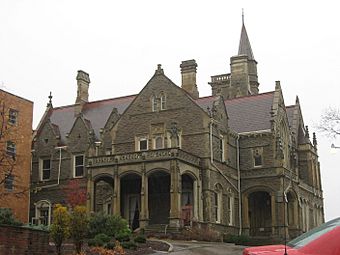Scarlet Oaks facts for kids
Quick facts for kids |
|
|
Scarlet Oaks
|
|

The main building at Scarlet Oaks
|
|
| Location | 440 Lafayette Ave., Cincinnati, Ohio |
|---|---|
| Area | Less than 1 acre (0.40 ha) |
| Built | 1867 |
| Architect | James Keys Wilson |
| Architectural style | Romanesque Revival, Gothic Revival |
| NRHP reference No. | 73001468 |
| Added to NRHP | March 7, 1973 |
Scarlet Oaks is a very old and large house in the Clifton area of Cincinnati, Ohio, United States. It was built in 1867. The famous architect James Keys Wilson designed it. The house shows a mix of two cool styles: Romanesque Revival and Gothic Revival.
Contents
History of Scarlet Oaks
Who Built Scarlet Oaks?
Scarlet Oaks was built for a rich businessman named George K. Schoenberger. He was from Pittsburgh but moved to Cincinnati. He wanted to open a part of his father's iron-making company there. George Schoenberger became very successful in Cincinnati. People even called him one of the "Seven Barons of Clifton." This was a group of important business leaders in this wealthy part of the city.
In 1883, Schoenberger married Ella Beatty. She was from Cobourg, Ontario. After George Schoenberger passed away in 1892, Ella married a composer named Charles A. E. Harriss. She then lived in a large house called "Earnscliffe" in Ottawa, Ontario.
A Grand Design
When it was built, Scarlet Oaks was the biggest house in Cincinnati. People have different ideas about how it was designed. Some local stories say it looked like a castle along the Rhine River in Germany. However, later experts who study buildings think no specific castle was copied. An old guidebook from the 1870s even said it looked more like French Gothic Revival architecture.
Scarlet Oaks quickly became well-known outside of Cincinnati. An early magazine about architecture, The American Architect and Building News, wrote a lot about it in 1876. Experts say its design was similar to the huge mansions built later during the Gilded Age. These include many Vanderbilt houses.
James Keys Wilson designed many houses. But by the 1960s, many of his buildings were gone. Scarlet Oaks was one of the few houses still standing that was definitely known as his work. This was partly because it was so famous. Since then, another house in Cincinnati, the John S. Baker House, has also been identified as a Wilson design. It was built in 1854.
Architecture and Features
Scarlet Oaks is a huge house made of limestone. It has two and a half floors. From far away, you can see its tall turret and other high towers. The house is so big that it stands out, even among other large homes in Clifton.
From Home to Retirement Center
Scarlet Oaks has not been a private home for over 100 years. In 1910, a person named E.H. Huenefeld bought it. He immediately gave it to local churches of the Methodist Episcopal Church.
Since then, the building has been used for groups of people. First, it was a sanitarium, which is like a health resort. Later, it was changed into a retirement home.
In 1973, Scarlet Oaks was added to the National Register of Historic Places. This means it is a very important historical place. Even though it is owned by a church, it was added because of its special and important architecture. Today, it is still used as a retirement home. It is now connected with the Deaconess Hospital.
See also
 In Spanish: Scarlet Oaks para niños
In Spanish: Scarlet Oaks para niños



